Southwest Decor Wall Art: Infuse Your Home with Desert-Inspired Charm
The allure of southwestern aesthetics has captivated homeowners and interior designers for generations, bringing the rugged beauty of arid landscapes into living spaces across the globe. This distinctive artistic approach celebrates the vast expanses of desert terrain, the resilient flora that thrives in harsh conditions, and the rich cultural heritage that defines this remarkable region. When transformed into canvas prints and wall decorations, these elements create powerful visual statements that infuse rooms with warmth, character, and a sense of adventure. The growing popularity of southwestern-themed artwork reflects a broader appreciation for natural beauty, earthy color palettes, and the timeless appeal of landscape imagery that connects us to the wild, untamed places of our world.
Embracing Southwest Style on Canvas
The essence of southwestern design translates beautifully onto canvas, creating artwork that captures the spirit of desert regions with authenticity and artistic flair. This aesthetic draws from the dramatic landscapes found throughout Arizona, New Mexico, Utah, and Texas, where towering rock formations meet endless skies and hardy vegetation punctuates the sandy terrain. Artists working in this genre skillfully balance realistic representation with stylized interpretation, producing pieces that honor the natural world while adding creative vision to their compositions.
Canvas prints featuring southwestern themes bring texture and depth to interior spaces, offering visual interest that flat posters cannot match. The fabric surface of canvas lends itself particularly well to desert subjects, as the subtle grain enhances the organic quality of rock faces, sand dunes, and weathered plant life. When properly stretched over wooden frames, these artworks gain a three-dimensional presence that makes them feel substantial and gallery-worthy, elevating the overall sophistication of room décor.
Selecting southwestern canvas art for your home means choosing pieces that resonate with your personal aesthetic while complementing existing furnishings and architectural features. The versatility of this style allows it to work equally well in contemporary minimalist settings and more traditional rustic environments. A large canvas depicting a sprawling desert vista can serve as a focal point above a sofa or fireplace, immediately drawing the eye and establishing the room's color scheme. Smaller pieces arranged in groups create compelling gallery walls that tell visual stories about the landscape and culture of the Southwest.
The color palette typical of southwestern canvas art includes warm earth tones like terracotta, burnt sienna, golden ochre, and sandy beige, often contrasted with the brilliant blues of desert skies and the deep purples of distant mountain ranges. These hues work harmoniously with many decorating schemes, particularly those incorporating natural materials like wood, leather, and stone. The warmth of these colors creates inviting atmospheres that feel grounded and comfortable, making spaces feel like true sanctuaries from the outside world.
Quality matters significantly when investing in southwestern canvas art. Well-produced prints feature sharp detail, accurate color reproduction, and proper canvas weight that resists sagging over time. Premium canvases are treated with protective coatings that resist fading from sunlight exposure, ensuring your investment maintains its visual impact for years. The stretching technique also affects longevity, with museum-quality stretching methods preventing warping and maintaining taut surfaces that showcase the artwork at its best.
Desert Vibes Wall Art
Desert-themed wall art channels the unique energy of arid environments, translating the stark beauty and surprising vibrancy of these ecosystems into visual experiences that transform interior spaces. This category encompasses a wide range of artistic interpretations, from photorealistic landscapes that document specific locations to abstract compositions that capture the essence of desert atmospheres through color, form, and texture. The common thread running through all desert vibes artwork is an appreciation for the distinctive qualities that make these environments so compelling.
The psychological impact of desert imagery in home settings should not be underestimated. These artworks often evoke feelings of spaciousness, tranquility, and freedom that counterbalance the confined nature of indoor living. A well-chosen desert print can make a small room feel more open by drawing the eye into distant horizons, creating an illusion of expanded space that benefits cramped urban apartments and cozy suburban homes alike. The meditative quality of desert landscapes, with their simplified compositions and harmonious color relationships, promotes relaxation and mental clarity.
Contemporary desert vibes wall art frequently incorporates elements beyond traditional landscape painting. Many pieces feature close-up studies of desert plants, focusing on the geometric patterns of succulent leaves or the delicate architecture of cactus spines. Others highlight the play of light and shadow across sand dunes, capturing the constantly shifting textures that define these dynamic environments. Some artists take more conceptual approaches, using desert motifs as jumping-off points for explorations of isolation, resilience, or the passage of time.
The versatility of desert-themed artwork extends to various room functions throughout the home. In living rooms, large-scale desert prints create conversation-starting focal points that reflect the homeowner's aesthetic sensibilities. Bedroom installations benefit from the calming properties of desert imagery, with softer compositions featuring pastel sunrise or sunset scenes promoting restful atmospheres conducive to sleep. Even functional spaces like home offices gain character from desert art, with the expansive nature of these landscapes subconsciously encouraging big-picture thinking and creative problem-solving.
Collecting desert vibes wall art allows for personal expression through curation. Some enthusiasts focus on specific geographic regions, assembling collections that document the unique characteristics of particular deserts like the Sonoran, Mojave, or Chihuahuan. Others organize their collections around themes such as desert wildlife, geological formations, or seasonal changes in arid environments. This focused approach to collecting creates cohesive visual narratives that demonstrate knowledge and passion while avoiding the haphazard appearance that can result from random acquisition.
Lighting considerations play crucial roles in displaying desert wall art effectively. These pieces often feature subtle gradations of tone that can be lost in poor lighting conditions, while proper illumination brings out the full richness of their color palettes. Track lighting with adjustable fixtures allows for precise highlighting of individual works, while picture lights mounted directly on frames provide elegant solutions for featured pieces. Natural light can beautifully illuminate desert art during daytime hours, though care must be taken to avoid direct sunlight that causes fading over extended periods.
Southwestern Home Décor Inspiration
Drawing inspiration from southwestern aesthetics creates opportunities to infuse living spaces with warmth, authenticity, and cultural richness that distinguishes homes from generic contemporary interiors. This design philosophy celebrates the architectural traditions, color palettes, and decorative elements characteristic of the American Southwest, blending Indigenous, Spanish Colonial, and Mexican influences into cohesive visual statements. Canvas art plays an integral role in southwestern home décor, serving not merely as decoration but as essential components that tie together color schemes, establish thematic consistency, and honor the cultural heritage that informs this beloved style.
Authentic southwestern interiors balance rustic elements with refined touches, creating spaces that feel both lived-in and carefully considered. Canvas artwork contributes to this balance by adding visual sophistication without sacrificing the earthy, grounded quality that defines the aesthetic. Pieces depicting traditional southwestern subjects like adobe architecture, mission churches, or pueblo settlements connect rooms to the region's built heritage, while landscape-focused works emphasize the natural environment that shaped local cultures and continues to inspire contemporary design.
Color coordination represents a critical aspect of southwestern home décor, with canvas art often serving as the starting point for room palettes. The terracotta reds, sunset oranges, and warm browns typical of southwestern paintings pair beautifully with furnishings in complementary earth tones, creating harmonious environments that feel intentionally designed rather than accidentally assembled. Accent colors pulled from canvas art, such as the turquoise of desert skies or the sage green of indigenous plants, can be echoed in throw pillows, pottery, textiles, and other decorative accessories to reinforce thematic unity.
Texture plays an equally important role in southwestern interiors, with the rough surface of canvas contributing to the tactile richness that characterizes well-executed spaces in this style. Canvas art pairs naturally with other textured elements common in southwestern décor, including woven rugs, hammered metal fixtures, carved wooden furniture, and handmade pottery. This layering of textures creates visual interest and depth that prevents rooms from feeling flat or one-dimensional, engaging multiple senses simultaneously to produce fully immersive environments.
Architectural features typical of southwestern homes provide ideal backdrops for canvas art. Exposed wooden beam ceilings, plastered walls with intentionally irregular surfaces, and rounded archways all complement the organic subject matter and warm tones of southwestern paintings. Even in homes lacking these architectural details, strategic placement of canvas art can suggest southwestern character, particularly when combined with appropriate furniture pieces and accessories that reference regional traditions.
Scale considerations matter tremendously when selecting southwestern canvas art for specific spaces. Large rooms with high ceilings can accommodate oversized pieces that make bold statements, while smaller areas benefit from more modest works or carefully arranged groupings of multiple canvases. The principle of proportion suggests that artwork should fill approximately two-thirds to three-quarters of available wall space above furniture pieces, creating balanced compositions that anchor seating areas or dining zones without overwhelming them.
Cactus and Desert Canvas Prints
Cacti have emerged as iconic symbols of desert environments, their distinctive silhouettes instantly recognizable and deeply associated with southwestern landscapes. Canvas prints featuring these remarkable plants bring botanical interest to interiors while celebrating the unique adaptations that allow these species to thrive in extreme conditions. From the towering saguaro cactus of Arizona to the clustered prickly pear varieties found throughout arid regions, these subjects offer endless artistic possibilities that range from scientifically accurate botanical illustrations to stylized graphic interpretations.
The visual appeal of cactus imagery extends beyond mere novelty. These plants possess inherently sculptural qualities, with their geometric forms, repetitive patterns, and architectural presence creating compositions that satisfy both aesthetic and intellectual interests. Artists working with cactus subjects explore these formal qualities through various approaches, some emphasizing the plants' graphic potential through simplified shapes and bold color contrasts, others delving into intimate details like the arrangement of spines or the delicate structure of flowers that bloom despite harsh surroundings.
Desert canvas prints featuring cacti work particularly well in modern and contemporary interiors where clean lines and minimalist sensibilities prevail. The stark simplicity of a single saguaro silhouetted against a clear sky complements sparse furnishing schemes and neutral color palettes, adding visual interest without cluttering spaces or competing with architectural features. Conversely, more densely composed cactus gardens or close-up studies of multiple plant varieties suit eclectic or maximalist décor styles, where abundance and variety are celebrated rather than minimized.
Educational value adds another dimension to cactus and desert plant prints, particularly in homes where appreciation for natural history and ecology factor into decorating decisions. Many high-quality prints include subtle details that reward close observation, teaching viewers about plant morphology, adaptation strategies, and the interconnected relationships between desert species and their environments. This educational aspect makes such artwork particularly appropriate for family homes, where children can develop appreciation for nature and scientific inquiry through daily exposure to thoughtfully chosen visual materials.
Seasonal considerations rarely affect the relevance of cactus canvas prints, as these evergreen subjects maintain their appeal year-round. Unlike flowering plant imagery that may feel incongruous during winter months or autumn harvest themes that lose resonance in spring, cactus art remains perpetually appropriate. This timeless quality makes these prints wise investments that continue serving their decorative purposes indefinitely without feeling dated or seasonally mismatched.
The growing popularity of indoor plant collections has increased appreciation for cactus and succulent imagery in recent years. Homeowners who maintain actual cactus collections often enhance their plant displays with complementary canvas art, creating cohesive botanical zones within their homes. This pairing of living specimens with artistic representations deepens the connection between indoor and outdoor worlds, satisfying biophilic design principles that recognize human needs for nature connection even in built environments.
Southwest Landscapes for Walls
Southwest landscape art captures the breathtaking vistas that define one of North America's most visually distinctive regions, translating vast desert expanses, dramatic rock formations, and endless skies into wall-appropriate formats that bring outdoor grandeur into interior spaces. These artworks span the full spectrum of landscape painting traditions, from plein air studies created on location to studio compositions that synthesize multiple observations into idealized scenes. Regardless of approach, the best southwest landscape prints convey the sense of scale, light quality, and atmospheric conditions that make these environments so memorable to those who experience them firsthand.
Geological drama provides much of the visual interest in southwest landscape art. The region's exposed rock formations, carved by millions of years of wind and water erosion, create natural sculptures that rival any human-made monument in their capacity to inspire awe. Artists depicting places like Monument Valley, Canyon de Chelly, or the Painted Desert must grapple with representing these massive structures in ways that communicate their scale while maintaining compositional balance. Successful works achieve this through careful manipulation of perspective, strategic placement of scale-providing elements, and attention to atmospheric effects that suggest depth and distance.
The quality of light in desert regions distinguishes southwestern landscapes from those depicting other environments. The low humidity and high elevation typical of much southwestern terrain create exceptionally clear atmospheric conditions that allow light to travel with minimal diffusion. This produces the crisp shadows, brilliant highlights, and intense color saturation that photographers and painters work to capture. Canvas prints that successfully reproduce these light qualities bring some of the desert's visual magic into homes, creating windows to distant places that expand perceived room boundaries.
Seasonal variations in southwestern landscapes offer artists and collectors diverse options for their artwork selections. Spring brings unexpected blooms that dot desert floors with colorful wildflowers, providing opportunities for more delicate compositions that contrast with the harsh reputation of these environments. Summer emphasizes the starkness and heat of peak desert conditions, with paintings often featuring bleached tones and shimmering heat distortions. Autumn introduces subtle color shifts in desert vegetation, while winter occasionally dusts high-elevation areas with snow, creating dramatic contrasts between white-capped peaks and warm desert valleys below.
Historical and cultural context enriches appreciation of southwest landscape art. These lands hold deep significance for numerous Indigenous peoples, whose presence spans thousands of years and whose artistic traditions influence contemporary southwestern visual culture. Respectful landscape art acknowledges this heritage through sensitive representation that avoids reducing these places to mere scenic backdrops, instead treating them as culturally meaningful locations with layered significance beyond their visual appeal.
The compositional challenges of landscape art become particularly apparent in desert subjects, where the absence of obvious focal points can make compositions feel empty or directionless. Skilled artists address this through various strategies, including dramatic skies that provide visual weight in the upper portions of compositions, foreground elements that create depth through overlapping planes, and careful value structures that guide viewers' eyes through scenes along predetermined visual paths. Understanding these compositional techniques helps collectors evaluate quality when selecting landscape prints for their homes.
Warm Desert Tones in Art
The color palette associated with desert environments offers artists and decorators a spectrum of warm hues that create inviting, comfortable atmospheres in residential settings. These tones, drawn from the earth itself, include the range of siennas, ochres, and umbers found in desert soils and rock formations, supplemented by the muted greens of desert vegetation and the warm grays of sun-bleached wood and stone. Canvas art employing this palette brings cohesive warmth to spaces while maintaining versatility that allows these pieces to coordinate with various decorating schemes and evolving style preferences.
Psychological research consistently demonstrates that warm colors promote feelings of comfort, energy, and social connection, making desert-toned artwork particularly appropriate for gathering spaces where families and friends congregate. Living rooms, dining areas, and kitchens all benefit from the welcoming quality these colors provide. The specific hues typical of desert art operate at moderate saturation levels that feel rich without becoming overwhelming, striking a balance between visual interest and restfulness that suits both active and relaxation-oriented spaces.
Understanding color temperature helps in successfully integrating desert-toned canvas art into existing décor schemes. While described as warm, desert palettes actually contain a range of temperatures, with some earth tones leaning toward cooler, grayer mixtures while others tend toward warmer, more orange-inflected versions. This internal variety within the palette provides opportunities for nuanced color coordination that prevents monochromatic boredom while maintaining thematic consistency. Selecting artwork with color temperatures that echo or deliberately contrast with room furnishings creates intentional color relationships that demonstrate decorating sophistication.
Natural light significantly affects how warm desert tones appear in interior settings. Rooms receiving abundant natural light showcase the full richness of these colors, with shifting sunlight angles creating dynamic viewing experiences as paintings appear slightly different throughout the day. Spaces with limited natural light may require artificial lighting strategies that prevent warm-toned artwork from appearing muddy or dull. Warm-temperature bulbs typically complement desert palettes better than cool-white options, though experimentation with specific combinations of artwork and lighting often yields the best results.
The durability of warm desert tones contributes to their long-term satisfaction as décor choices. Unlike trendy color schemes that feel dated within a few years, earth-based palettes possess timeless qualities rooted in natural rather than fashion-driven color theory. This permanence makes desert-toned canvas art wise investments that continue complementing homes through multiple decorating updates and style evolutions. The colors remain relevant whether paired with contemporary furnishings, traditional pieces, or eclectic combinations that defy categorization.
Layering different warm tones creates sophisticated color stories within individual rooms or throughout entire homes. A large canvas dominated by terracotta and rust tones might anchor a living room, with smaller pieces in related but distinct warm hues like golden yellow or burnt orange extending the palette into adjacent spaces. This approach to color distribution creates visual flow that guides movement through homes while allowing individual rooms to maintain distinct identities within an overarching color framework.
Southwest Motifs on Canvas
Traditional southwestern motifs provide artists with a rich vocabulary of symbolic and decorative elements that communicate cultural heritage while creating visually compelling compositions. These design elements, drawn from Indigenous pottery patterns, Navajo weaving traditions, Mexican tile work, and Spanish Colonial architectural ornament, offer alternatives to purely landscape-based southwestern art. Canvas prints featuring these motifs work particularly well in spaces where pattern and design take precedence over representational imagery, suiting modern interiors that embrace graphic boldness and cultural eclecticism.
Geometric patterns dominate traditional southwestern design, with stepped pyramids, zigzag lightning bolts, and diamond lattices appearing repeatedly across various cultural traditions. These shapes carry specific meanings within their original contexts, often relating to natural phenomena, spiritual concepts, or clan identifications. Contemporary artists working with these motifs sometimes maintain traditional color palettes and symbolic associations, while others reinterpret classic forms through modern color schemes and compositional approaches that honor heritage while asserting artistic independence.
The translation of three-dimensional craft traditions into two-dimensional canvas art presents interesting creative challenges. Pottery designs that wrapped around curved surfaces must be flattened or abstracted, weaving patterns must be scaled and isolated, and architectural elements must be extracted from their structural contexts. Artists navigate these challenges through various strategies, creating works that reference their sources while functioning as independent visual statements suitable for display in contemporary interiors far removed from their cultural origins.
Ethical considerations surround the use of Indigenous motifs by non-Native artists, particularly when traditional designs are appropriated without acknowledgment or understanding of their cultural significance. Responsible artists and art publishers approach southwestern motifs with respect, often collaborating with Native artists, clearly crediting cultural sources, and avoiding the use of sacred symbols in commercial contexts. Collectors can support ethical practices by researching the origins of motif-based artwork and favoring pieces created by Native artists or those working in respectful partnership with Indigenous communities.
The bold graphic quality of southwestern motifs makes them particularly effective as focal points in minimalist interiors where they can shine without competing against busy patterns or cluttered arrangements. A large canvas featuring a single, dramatically scaled motif creates powerful visual impact that rivals abstract expressionist paintings while maintaining accessibility through recognizable forms and cultural associations. This combination of aesthetic strength and cultural grounding gives motif-based southwestern art unique positioning within the contemporary art market.
Mixing motif-based artwork with landscape pieces creates visual variety within southwestern design schemes. A gallery wall might combine a geometric pattern canvas with several desert landscape prints, the graphic boldness of the motif piece providing structural contrast to the more organic forms found in nature-based works. This mixing prevents southwestern interiors from feeling monotonous while maintaining thematic consistency that ties diverse elements into unified presentations.
Rustic Desert Wall Décor Ideas
Rustic design approaches emphasize natural materials, weathered finishes, and handcrafted qualities that celebrate imperfection and age rather than sleek perfection. When combined with desert themes, rusticity creates particularly authentic southwestern aesthetics that honor the region's frontier heritage and the resourcefulness required to build comfortable lives in challenging environments. Canvas art contributes to rustic desert décor through subject matter choices, frame selections, and display strategies that enhance rather than contradict the weathered, earthy character of this enduring design style.
Subjects particularly suited to rustic desert presentations include weathered barns and abandoned structures slowly returning to the landscape, vintage pickup trucks rusting in desert settings, and old fences marking long-unused boundaries. These imagery choices celebrate the passage of time and human presence in desert regions, telling visual stories about settlement, persistence, and eventual surrender to nature's patient reclamation. The nostalgic quality of such subjects appeals to those who value history and authenticity over pristine modernity.
Frame selection dramatically affects whether canvas art reads as rustic or refined. Distressed wood frames with visible grain, knots, and color variations enhance rustic presentations, their imperfect surfaces complementing weathered subjects and natural materials elsewhere in rooms. Alternatively, leaving canvas edges unframed creates casual presentations that feel unpretentious and approachable. Some collectors prefer barn wood frames constructed from reclaimed materials, adding authentic age and history to artwork displays while supporting sustainable practices and craft traditions.
Layering contributes significantly to successful rustic desert décor, with canvas art functioning as one element within multidimensional wall presentations. A desert landscape canvas might be displayed alongside vintage ranch tools, antique horseshoes, or collections of antlers and weathered wood, creating vignettes that engage viewers with texture and depth impossible to achieve through artwork alone. This approach transforms walls into curated displays that reflect personal interests and collected treasures rather than merely decorated surfaces.
The concept of intentional imperfection guides rustic design choices, including decisions about artwork condition and presentation. While pristine, perfectly executed prints suit some décor styles, rustic presentations can actually benefit from pieces with character marks, intentionally distressed finishes, or handmade qualities that reveal their construction. This acceptance of imperfection creates relaxed, welcoming atmospheres where guests feel comfortable rather than worried about disturbing carefully maintained perfection.
Mixing vintage and contemporary elements prevents rustic desert décor from feeling like period recreations or museum installations. A nineteenth-century landscape reproduction might hang beside a contemporary photographic print, both sharing desert subjects but representing different artistic moments and technical approaches. This temporal mixing creates living spaces that honor history while remaining firmly grounded in present-day life, avoiding the theme-park quality that can afflict overly committed historical recreations.
Cultural Southwest Canvas Prints
The cultural richness of southwestern regions provides endless inspiration for canvas art that celebrates the diverse peoples, traditions, and artistic practices that have shaped these areas over millennia. Cultural southwest prints span subjects including Indigenous ceremonies and daily life, Spanish Colonial missions and festivals, Mexican markets and celebrations, and the multicultural fusion that characterizes contemporary southwestern communities. These works offer alternatives to pure landscape imagery, introducing human presence and cultural narrative into home décor while educating viewers about the complex heritage of these regions.
Respectful representation remains paramount when displaying cultural imagery from traditions outside one's own background. Art that reduces living cultures to decorative motifs or freezes Indigenous peoples in romanticized historical moments perpetuates harmful stereotypes rather than honoring actual cultural complexity. Ethical collectors seek work by artists from the depicted communities or those working in genuine collaboration with cultural insiders, ensuring that representations come from informed perspectives rather than outsider fantasies.
Traditional dress and regalia provide visually striking subjects for cultural canvas prints, with the elaborate beadwork, weaving, and silverwork characteristic of southwestern Indigenous peoples creating compositions rich in pattern, color, and craftsmanship. These images document artistic traditions of tremendous sophistication while showcasing cultural pride and continuing creative vitality. High-quality prints reveal the intricate details of these cultural objects, allowing viewers to appreciate craftsmanship that might otherwise be seen only in museum settings or at cultural events.
Architectural subjects document the built environment of southwestern cultures, from ancient cliff dwellings and pueblo structures to Spanish mission churches and Mexican haciendas. These buildings represent adaptations to desert environments using locally available materials and construction techniques refined over generations. Canvas prints featuring architectural subjects satisfy interests in design history while providing visually interesting compositions of forms, shadows, and textures that work well in various interior settings.
Contemporary southwestern art often addresses cultural fusion and border experiences, creating works that reflect the complex realities of regions where multiple cultural traditions intersect and influence each other. These pieces may incorporate Spanish text, reference migration experiences, or blend traditional motifs with contemporary artistic languages, producing work that speaks to current social realities rather than nostalgic historical visions. Collecting such contemporary cultural prints supports living artists while bringing fresh perspectives into home environments.
The educational potential of cultural canvas prints extends beyond visual appreciation, offering opportunities for learning about history, anthropology, and cultural diversity. Families with children particularly benefit from thoughtfully chosen cultural artwork that normalizes diversity and demonstrates respect for traditions different from their own. Conversations sparked by cultural prints can introduce topics of heritage, adaptation, and cultural exchange in accessible ways that complement formal education.
Sunset Over the Desert Wall Art
Few natural phenomena match the visual drama of desert sunsets, when dust particles and atmospheric conditions create spectacular light shows that transform ordinary landscapes into surreal displays of color and radiance. Artists have long recognized the powerful appeal of sunset imagery, and desert settings provide particularly effective backdrops for these ephemeral events. Canvas prints capturing sunset moments offer homeowners opportunities to bring the magic of these fleeting experiences into their daily lives, creating wall art that never fails to attract attention and spark emotional responses.
The color intensity of desert sunsets results from atmospheric optics combined with the dry conditions and dust particles typical of arid environments. As sunlight passes through increasing thicknesses of atmosphere during sunset hours, shorter wavelengths of light scatter away while longer red and orange wavelengths penetrate through, creating the warm color dominance characteristic of golden hour and sunset periods. Desert dust enhances these effects, adding particles that further scatter light and sometimes create unusual color phenomena rarely seen in more humid regions.
Compositional approaches to sunset art vary widely, from silhouette treatments that emphasize shape and form against brilliantly colored skies to more evenly balanced compositions that give equal weight to landscape and atmosphere. Silhouette approaches work particularly well with distinctive southwestern landforms like saguaro cacti or balanced rock formations, creating instantly recognizable regional markers while maintaining graphic simplicity. More complex compositions that maintain landscape detail throughout the tonal range offer richer viewing experiences that reward extended observation.
The emotional associations of sunset imagery make these prints particularly suitable for spaces dedicated to relaxation and reflection. Bedrooms benefit from the calming effect of sunset art, with the warm colors and associations with day's end promoting restfulness and sleep preparation. Meditation spaces or reading nooks similarly gain from sunset imagery that encourages quiet contemplation and mental decompression from daily stresses.
Technical considerations affect the success of sunset canvas prints, as the extreme contrast ranges and subtle color gradations characteristic of these scenes challenge reproduction capabilities. High-quality prints from reputable publishers maintain the delicate color transitions and luminous quality of well-captured sunset images, while inferior productions lose these subtleties, resulting in muddy gradations or posterized color bands. Examining print quality before purchase helps ensure satisfaction with these challenging subjects.
Collecting multiple sunset prints allows for documentation of the infinite variety within this single subject category. Each sunset is unique, affected by seasonal atmospheric conditions, cloud formations, and the specific viewing location. A collection might include winter sunsets with cool undertones, summer displays featuring dramatic storm clouds, or simple clear-sky events that showcase pure color gradations. This focused collecting approach creates thematic unity while demonstrating the diversity possible within seemingly narrow parameters.
Southwest-Inspired Interior Canvas Art
Southwest-inspired interior design draws from regional aesthetics without attempting literal recreation of specific historical styles or locations. This approach allows for creative freedom and personal expression while maintaining connection to southwestern visual traditions, color palettes, and cultural associations. Canvas art plays a central role in establishing southwest-inspired atmospheres, providing visual anchors that communicate intended style directions to residents and visitors alike.
The concept of inspiration rather than replication permits mixing of southwestern elements with other design traditions, creating eclectic interiors that feel globally informed rather than regionally limited. A southwest-inspired living room might combine Navajo-pattern textiles with Moroccan lighting fixtures and Scandinavian furniture, unified by a thoughtfully selected canvas print featuring desert landscapes or cultural motifs. This cosmopolitan approach appeals to well-traveled homeowners who appreciate diverse aesthetic traditions and resist single-style conformity.
Color extraction from canvas art provides a practical method for developing southwest-inspired interiors. A carefully chosen desert landscape print can serve as a color scheme blueprint, with specific hues present in the artwork repeated in paint colors, upholstery fabrics, and decorative accessories. This approach ensures color coordination while building cohesive visual environments that feel intentionally designed. Digital tools and apps that extract color palettes from images can assist this process, identifying specific paint colors that match canvas art tones.
Scale and proportion considerations become particularly important when canvas art anchors southwest-inspired design schemes. Oversized pieces make bold statements appropriate for open-plan spaces or rooms with high ceilings, while more modest works suit intimate settings or serve as components within gallery wall arrangements. The principle of proper proportion suggests that primary artwork should relate logically to the furniture and architectural features it accompanies, neither disappearing through excessive smallness nor overwhelming through inappropriate largeness.
Flexibility represents a key advantage of southwest-inspired approaches over strict adherence to specific historical styles. As tastes evolve or life circumstances change, individual elements can be updated without requiring complete room overhauls. A canvas print might remain constant while surrounding furnishings and accessories transition from rustic to modern expressions of southwestern aesthetics, demonstrating the long-term value of quality artwork that transcends temporary trends.
Budget-conscious approaches to southwest-inspired decorating often begin with canvas art as foundational investments around which more affordable elements are arranged. A significant desert landscape or cultural print can elevate even modest furnishings, providing visual sophistication that compensates for less expensive supporting pieces. This strategy allows for incremental upgrades over time, with furniture and accessories gradually improving while the artwork provides consistent quality and style direction.
Desert Beauty Captured in Prints
The unique beauty of desert environments challenges conventional notions of natural attractiveness, requiring viewers to appreciate subtlety, adaptation, and harsh elegance rather than the lush abundance typically associated with beautiful landscapes. Photographic and painted prints that successfully capture desert beauty translate these challenging qualities into accessible visual experiences that communicate the profound appeal of arid regions to those who might never visit them personally. Understanding what constitutes desert beauty helps collectors select prints that authentically represent these remarkable places.
Minimalism characterizes much desert beauty, with vast empty spaces punctuated by occasional landforms or vegetation creating compositions of elegant simplicity. This natural minimalism appeals to contemporary aesthetic sensibilities that value edited visual experiences over busy complexity. Canvas prints emphasizing this quality feature generous negative space, limited color palettes, and careful attention to the few elements present within compositions, creating meditative viewing experiences that offer visual rest in cluttered modern lives.
Survival adaptations of desert organisms provide another dimension of beauty worth capturing in print form. Close examination reveals remarkable details like the water-storing tissues of succulents, the protective spine arrangements of cacti, or the deep root systems that allow desert trees to access underground moisture. Artists and photographers who document these adaptations create works that satisfy both aesthetic and intellectual interests, appealing to viewers who appreciate the problem-solving elegance of evolutionary design.
Temporal beauty marks desert experiences, as these environments undergo dramatic transformations throughout daily and seasonal cycles. Morning light creates long shadows and cool tones, midday sun bleaches colors and flattens forms, while evening brings warm glows and renewed shadows from opposite directions. Seasonal changes, though subtle compared to temperate regions, nevertheless affect vegetation colors, wildflower blooms, and the presence or absence of ephemeral water features. Prints capturing specific temporal moments document this changeability while freezing particular instances for permanent appreciation.
The concept of beauty in harshness challenges viewers to expand their aesthetic appreciation beyond comfortable prettiness. Desert environments embody a beauty that includes danger, difficulty, and death alongside life and adaptation. Canvas prints that honestly represent this complexity create more meaningful art than sanitized romantic visions that ignore the real challenges of these places. This authentic approach respects both the environments depicted and the intelligence of viewers.
Discovering personal connections to desert beauty often requires extended exposure through quality prints displayed in daily environments. Initial reactions to desert imagery may be neutral or even negative for those unfamiliar with these landscapes, but continued viewing typically develops appreciation as subtleties become apparent and compositional strengths emerge. This acquired taste dimension makes desert prints rewarding long-term investments that deepen in meaning rather than losing interest through overfamiliarity.
Southwest Cactus Wall Décor
The distinctive forms of southwestern cacti have achieved iconic status in visual culture, representing desert environments in shorthand that requires no explanation. Wall décor featuring these remarkable plants spans the range from scientific botanical illustrations to playful graphic treatments, offering options for various decorating sensibilities and room functions. The enduring popularity of cactus imagery reflects both aesthetic appeal and cultural associations with resilience, independence, and natural beauty in unexpected places.
Variety within cactus species provides extensive options for collectors seeking specific aesthetic qualities. The massive columnar forms of saguaro cacti create dramatically vertical compositions with strong visual impact, while the sprawling paddle-shaped segments of prickly pear varieties offer more horizontal emphasis. Barrel cacti present nearly geometric circular forms, and the branching structures of cholla cacti create complex linear networks. Understanding these formal differences helps in selecting pieces appropriate for specific wall dimensions and decorating intentions.
Humor enters cactus wall décor through anthropomorphic representations that play on the vaguely humanoid proportions of certain species or through text-based designs pairing cactus images with puns and wordplay. These lighthearted approaches suit casual spaces like kitchens, bathrooms, or children's rooms where playfulness is welcome. Balance becomes important when mixing humorous cactus décor with more serious pieces, ensuring that rooms maintain appropriate tones for their functions.
Black and white cactus photography offers sophisticated alternatives to color imagery, emphasizing form, texture, and tonal relationships over chromatic appeal. These monochromatic pieces coordinate easily with various color schemes and often feel more artistic and gallery-worthy than their color counterparts. The high contrast inherent in many cactus subjects translates particularly well to black and white treatment, creating graphic strength that holds attention across rooms.
Seasonal appropriateness rarely concerns cactus wall décor, as these evergreen subjects maintain relevance year-round. Unlike deciduous plant imagery that may feel seasonally mismatched or flower subjects that suggest specific times of year, cactus décor works equally well in all seasons. This timeless quality contributes to the enduring popularity of these subjects and makes them reliable choices for permanent installations rather than rotational seasonal displays.
Pairing living cactus collections with cactus wall art creates cohesive botanical themes within homes. The three-dimensional reality of actual plants complements two-dimensional artistic representations, with each enhancing appreciation of the other. This combination satisfies biophilic design principles that recognize human needs for nature connection while allowing expression of specific plant interests and collecting passions.
Warm Toned Desert Canvas Prints
Warm-toned desert canvas prints emphasize the heat and sunshine inherent to arid landscapes by highlighting rich oranges, reds, yellows, and browns over cooler hues. These artworks evoke the vibrant energy of the desert sun, making them ideal for social spaces or rooms where warmth and activity are desired. By understanding color psychology, homeowners can strategically place warm-toned prints to enhance the emotional qualities of each space—encouraging conversation, creativity, or comfort depending on the setting.
The intensity of warm tones in desert prints varies widely, offering everything from subtle earth tones that gently whisper warmth to bold, saturated sunset scenes that command attention. Prints with modest intensity offer versatility, coordinating seamlessly with diverse furnishing styles and enabling easy room updates without clashing colors. In contrast, high-intensity warm prints serve as striking focal points, infusing a room with dynamic energy and commanding the viewer’s eye.
Incorporating warm-toned desert canvas art can transform any space by bringing the essence of the Southwest indoors. These prints celebrate the natural palette of desert vistas and complement rustic, southwestern, and even modern décor. Whether adorning living rooms, dining areas, or creative studios, they invite an inviting warmth that inspires both relaxation and vitality.By carefully selecting warm desert canvases that match your space’s atmosphere and purpose, you can craft an environment that reflects both the beauty of the natural world and your personal style—turning walls into windows overlooking sun-drenched horizons.
Conclusion
In conclusion, Southwest decor wall art offers a unique and captivating way to infuse your home with the warm, earthy charm of the desert. Rooted in the rich cultural heritage and natural beauty of the American Southwest, this style of wall art celebrates the rugged landscapes, vibrant colors, and timeless traditions that define the region. By incorporating Southwest-inspired pieces into your décor, you not only create a visually stunning environment but also connect with a deeper sense of place, history, and authenticity.
One of the most alluring aspects of Southwest wall art is its ability to evoke the natural beauty of the desert environment. The warm palette of terracotta, rust, turquoise, ochre, and sandy beige mirrors the iconic hues of desert sunsets, rock formations, and native flora. Whether through abstract paintings, detailed illustrations, or textured mixed-media pieces, this art captures the essence of the desert’s vast skies, towering cacti, and sunbaked earth. Such imagery brings a sense of tranquility, grounding, and natural wonder into any space, transforming a home into a serene retreat from the hustle and bustle of modern life.
Beyond its color schemes and landscapes, Southwest decor wall art is deeply connected to Indigenous and Hispanic cultural motifs. Traditional patterns, symbols, and artistic techniques reflect the rich histories and spiritual beliefs of Native American tribes and Southwestern communities. Incorporating these elements thoughtfully and respectfully adds layers of meaning to your décor, honoring the craftsmanship and stories passed down through generations. This cultural richness invites curiosity, appreciation, and a sense of reverence, making your living space not only beautiful but also meaningful.
Southwest wall art also offers remarkable versatility in how it can be incorporated into various interior styles. Whether your home embraces rustic, bohemian, contemporary, or eclectic aesthetics, desert-inspired artwork can seamlessly complement and enhance your existing décor. Bold prints featuring desert wildlife, minimalist line drawings of mesas and canyons, or vibrant textile-inspired patterns can each contribute a distinctive flair. The ability to mix and match different mediums—such as canvas paintings, woven tapestries, and metal sculptures—adds depth and texture, creating a rich visual tapestry that celebrates the Southwest’s diversity.
Furthermore, choosing Southwest decor wall art encourages a connection to nature and sustainability. Many pieces are crafted from natural or recycled materials, emphasizing eco-friendly practices that align with the desert’s fragile ecosystem. Supporting local artists and artisans who draw inspiration from their environment also fosters community resilience and preserves traditional art forms. By making conscious choices in your décor, you contribute to the preservation of cultural heritage and environmental stewardship, creating a home that reflects values as well as style.
Another important benefit of Southwest-inspired wall art is its ability to foster a sense of calm and mindfulness. The imagery of open skies, desert landscapes, and timeless natural forms invites contemplation and relaxation. This peaceful aesthetic encourages moments of stillness, making it ideal for spaces meant for unwinding and reflection, such as living rooms, bedrooms, or meditation corners. The warm tones and organic shapes help create an inviting atmosphere that nurtures emotional well-being and balance.
Additionally, Southwest decor wall art can serve as a storytelling medium, connecting your personal journey with the broader narrative of the land and its people. Each piece can represent a meaningful encounter, a place visited, or a cultural appreciation, turning your home into a living gallery of memories and inspirations. This personalization fosters a deeper emotional bond with your surroundings, making your space feel authentic and uniquely yours.
In essence, Southwest decor wall art is more than just decoration—it is a celebration of a region rich in natural beauty, cultural heritage, and artistic innovation. By thoughtfully infusing your home with desert-inspired charm, you create spaces that are visually captivating, emotionally resonant, and spiritually enriching. This style invites you to slow down, appreciate the subtle wonders of nature, and honor the timeless stories woven into the fabric of the Southwest.
Whether you are drawn to bold colors and intricate patterns or prefer understated and minimalist desert motifs, Southwest wall art provides endless inspiration to elevate your home décor. It encourages a harmonious blend of tradition and modernity, nature and culture, warmth and simplicity. By embracing this aesthetic, you transform your living space into a refuge that reflects the beauty, resilience, and soul of the desert landscape.
Ultimately, Southwest decor wall art empowers you to create a home that feels grounded, welcoming, and full of character—a place where the spirit of the desert is alive in every brushstroke, texture, and design. It is an artistic journey that celebrates connection, creativity, and a deep appreciation for one of the most unique and inspiring regions in the world.



































